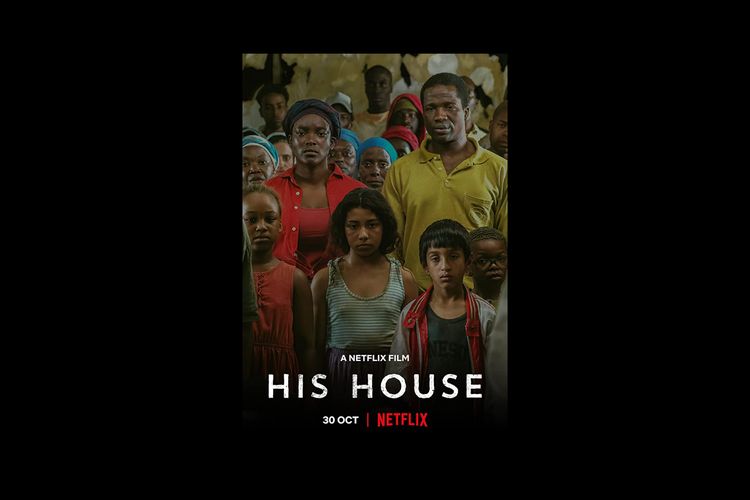
Poster film His House (2020), tayang mulai 30 Oktober di Netflix.(Netflix)
when Horror Yearbook – The His House true horror becomes clear from the moment the story begins, not because of monsters hiding in the dark, but because fear already lives inside the hearts of the main characters. The film follows a young Sudanese refugee couple who escapes war and seeks safety in the United Kingdom. They believe a new life will offer healing, but the peace they hope for quickly turns into another nightmare. His House uses supernatural terror as a mirror — a way to show how trauma, grief, and guilt often follow people even when they cross borders. And while the film presents dark spirits on-screen, the deeper fear comes from something more human: the pain of losing home and the uncertainty of starting over in a world that doesn’t always welcome you.
At first, the refugee couple arrives with cautious hope. They accept a government-assigned house, believing it will give them a chance to rebuild their lives. Yet the moment they settle into the small, dimly lit space, something feels wrong. The walls echo with whispers. Shadows move when no one is there. Small objects fall on their own as if someone — or something — wants to be noticed.
What makes His House powerful is how it blends real fear with supernatural terror. The couple carries the emotional wounds of escaping Sudan, and the house becomes a physical representation of that burden. The more they try to ignore what happens inside the walls, the stronger the terror grows.
This approach hits deeply because many people who flee conflict bring invisible scars with them. PTSD, survivor’s guilt, and cultural displacement often linger long after they leave danger. His House turns these invisible pains into chilling encounters that remind us how trauma can feel like a haunting.
Other Information :
As nights grow longer, the terror intensifies. The couple sees visions — a figure hiding in the corner, a whisper calling their names, and shadows crawling through the house. While these moments deliver traditional horror chills, His House goes further. Each haunting reveals fragments of their past: memories of loss, the desperate journey across the sea, and the guilt of the loved ones they couldn’t save.
The film doesn’t simply show ghosts; it reveals how trauma hunts the survivors.
The husband tries to stay strong. He wants to keep their opportunity in the UK because he fears being sent back to the place they barely escaped. He refuses to report the disturbances, knowing authorities could revoke their temporary status if they complain too much. His silence builds tension and creates conflict within the marriage.
The wife, meanwhile, struggles differently. She begins to see apparitions of someone she once loved. The visions blur the lines between memory and haunting, making her question whether the terror is real or born from her grief.
Through these emotional layers, the His House true horror becomes more than a ghost story. It becomes a portrait of how people fight to survive even when their minds and hearts feel broken.
The film also highlights how refugees often live in a system that demands gratitude even when conditions are unsafe. They must appear thankful, quiet, and obedient — even if they face dangers inside the homes they are given. This emotional pressure adds a chilling realism to the supernatural storyline.
Despite the terror, His House is not just about fear. It is also about healing and facing the truth. The ghosts that appear are not simply spirits meant to harm; they represent unfinished stories, unspoken pain, and unresolved trauma.
As the couple confronts their past, they uncover that the darkest force haunting them is not the spirit in the house. Instead, it is the guilt from what they had to do to survive — the choices no one should ever be forced to make. This emotional revelation transforms the film’s message. Horror isn’t only about what lurks in the shadows; sometimes it is about what lives within us.
By the end, the couple decides to stop running. They stand together, face the darkness, and choose to accept the truth of their past. This decision does not erase their pain, but it gives them a chance to start healing. It also symbolizes something important: survival is not only about escaping danger; it is about finding strength after the escape.
In the end, His House true horror leaves viewers with more than fear. The film offers deep empathy, especially toward those who have lived through conflict. Through every scene, we see how refugees carry stories far heavier than the world often realizes. Trauma does not disappear when someone crosses an ocean; it lingers, and the path toward healing demands a quiet kind of courage that many people never notice.
The couple’s journey shows that darkness can be faced, and even the deepest wounds can begin to mend when truth meets courage. While His House is a horror film, its heart lies in humanity — the resilience of people who have already survived the unimaginable.
And perhaps that is the real horror and beauty of the story: even in the shadows, hope can still rise.